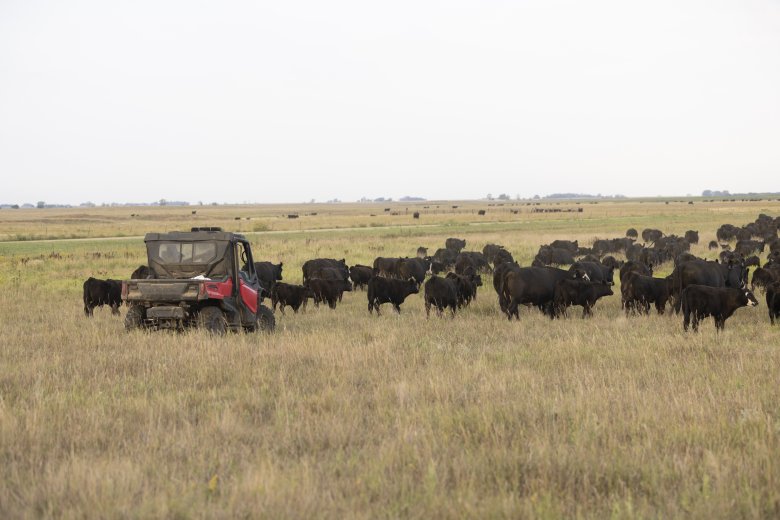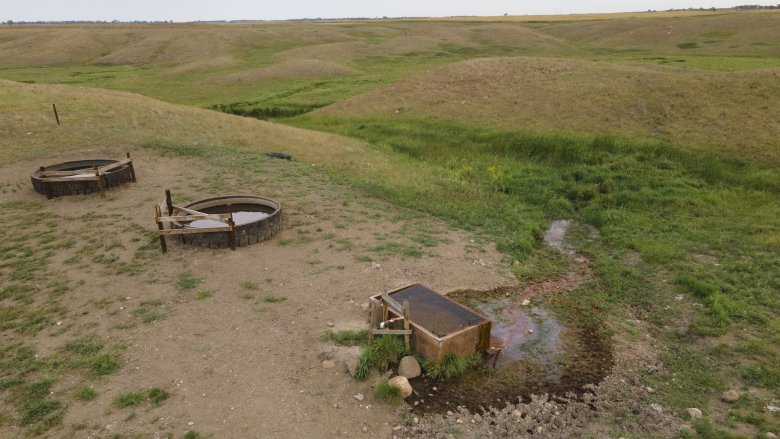Content ID
Rotational grazing revival

Leigh Talley, a non-operating land owner in Sanborn County, South Dakota had a dilemma.
The fourth-generation landowner viewed the ownership of his acres as an exercise in long-term stewardship. But he was stuck.
- READ MORE: Starting to farm with no excuses
“I was looking for a way to utilize a cow herd as a management tool to do some rehabilitation,” he says. Talley had learned that less than 2% of native prairie tallgrass is remaining in the United States, and he viewed it as his responsibility to take care of that depleted resource.
That meant hooves on the ground. Many, many hooves.
But, how?
Enter Tyler Moore. And bring on the cows — lots of ‘em.

“Tyler and I, in one sense, have a traditional landlord/tenant relationship in that he sought me out looking for a place to run cattle,” Talley says. “His timing was fortuitous for both of us. It was really lucky. We have a big chunk of ground out here that is native pasture. The long-term grazing practices we’d used out here haven't been healthy in my opinion. I'm not an ecologist or a biologist by training, but the long-term grazing techniques were good for cattle, but not very good for the soil and the kind of prairie environment — the Prairie biome that's out here.”
Moore’s story is one of cooperation, innovation, resilience, and of learning. And more importantly, putting what he learned into practice.
Moore partnered with his cousin Dave Grassel to secure the grazing rangeland from the Talley Farm, and they’re making it all work.
“There's a lot of moving of cattle back and forth,” Grassel says. “It’s a big group of cows. So we need extra helpers to make that all work.”
- READ MORE: How to manage grassland stressed by drought
It’s worth the effort.
“I always joke with my girls, telling them, ‘We can sell these cows any day and we can move to town,’ and they always say, ‘No, no, Dad, we got to keep the cows,’” Moore says.
“They enjoy what we do and the life we live,” Moore says. “I met Krista right out of college and we have three kids, Harper, Claire, and Everett, who just turned two. They're a big part of our daily life, moving cows. My wife's a school teacher, so she has her summers off."

Three seasons ago, Moore lost some of his grazing acres due to a land sale. He was about to sell off 75 cow-calf pairs to make things work for his operation when got a call from a former agriculture teacher who knew about some available grazing land that would handle probably 200 head. Then, the problem was too much land, not enough animals to handle it.
That kicked off the partnership with his cousin, who Tyler says, “is a very good operator with very good cattle.” They talked it over and decided then and there to run their cattle together. Teamwork.
Grassel tells his side of it. “The opportunity to rent some grass together was a little more than either one of us wanted to take on by ourselves. We then approached the landowner and told them that if we were given the opportunity to rent the land, that we would rotationally graze it. And they actually took us up on that. We even underbid some fellow ranchers, but we offered to rotationally graze and the landowners thought that'd be a better deal for everybody in the long run."
Tyler interjects, “And after pitching my line and promoting grass, you find that there are people out there who aren't always interested in the highest dollar all the time. It really opens your eyes to learn that what we're doing is something that nobody else around here is doing. It probably makes for a lot of coffee talk.”
“Promoting healthy grass is probably one of the biggest reasons why we got to where we're at. We’re opening people’s eyes a bit,” he smiled.
Tyler talks about his history and reflects on what he’s learned, and how that’s gotten him to this healthy grassland mindset.
“Growing up I always heard of NRCS, but didn’t really know much in detail,” he says. “Someone recommended that we go to a grazing school after we started running cows up near Watertown, and that was probably our main eye-opener. That grazing school was a huge part of getting to where we're at today. We learned how to figure out warm and cool season grasses, how to distinguish grass types, and the best time of year to utilize those grasses. That was a huge tool.”

After attending the school, Moore and Grassel reached out to their local office and started figuring out a way to utilize their paddocks, plus how to set up water tanks and cross fences.
“The first year we set up probably close to six miles of single-strand hot-wire fences, and did what we could do with the water available. This last year, we really went to the drawing board and set up more water sources and through the NRCS we enrolled in an EQIP contract. Now we’re setting water tanks, drilling wells, and digging more water line. It's not too often somebody comes to you and says, here's X many dollars to invest in your ground,” he smiles. “And without it, we couldn't do what we're doing today.”
Moore says one of the most important things they’ve done has been the cross fencing.
Continuing, he adds, “The biggest misconception is people don’t fully understand how grass works. They don’t know how to utilize warm and cool season grasses. They can look at their pastures and say they have grass, but they don't fully grasp when the best time to utilize that grass is. It’s best if you can be ready to adjust your grazing schedule by the types of grasses you have.”
That partnering thing is going very well, even if it’s a lot of work.
“We do a lot of walking cows down a road around here. We have a lot of pastures that are close together, but some are two and a half, three miles away,” says Moore. “I had a neighbor ask, ‘How do you walk 180 cows down the road?’ It takes a little more manpower. That's where having this partnership with a good friend of mine comes into play. I get my father and his father, we round up a few more guys, and we get it done.”

Grassel comments about the partnership, “It is unique and we do have differing ideas every once in a while. We butt heads. But we’re probably a little bit more like brothers and we are friends most of the time. When he thinks sometimes that we should be moving cattle, I think maybe we’ve got to leave them another half a day. It always tends to work out pretty well.”
Last year, they ran a hundred head together and this year, found an opportunity to add more grass.
“We were approached by the landowner because of our rotational grazing practices and we're running 180 pair together right now,” says Grassel.
“Tyler said a long time ago, ‘You can never have too many contacts; your reputation is everything.’ If you have a good reputation, if you do good job and are a good steward of the land, people will they'll recognize that. And in the long run it will help you out.”
Tip of the Day
When you mow in a remote area




